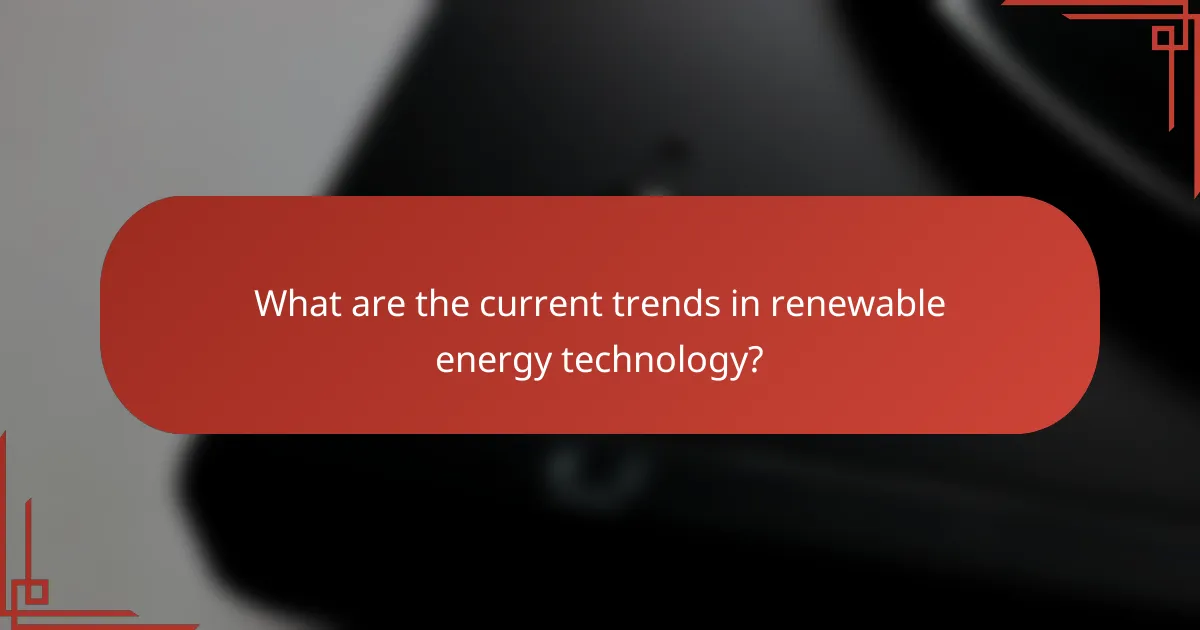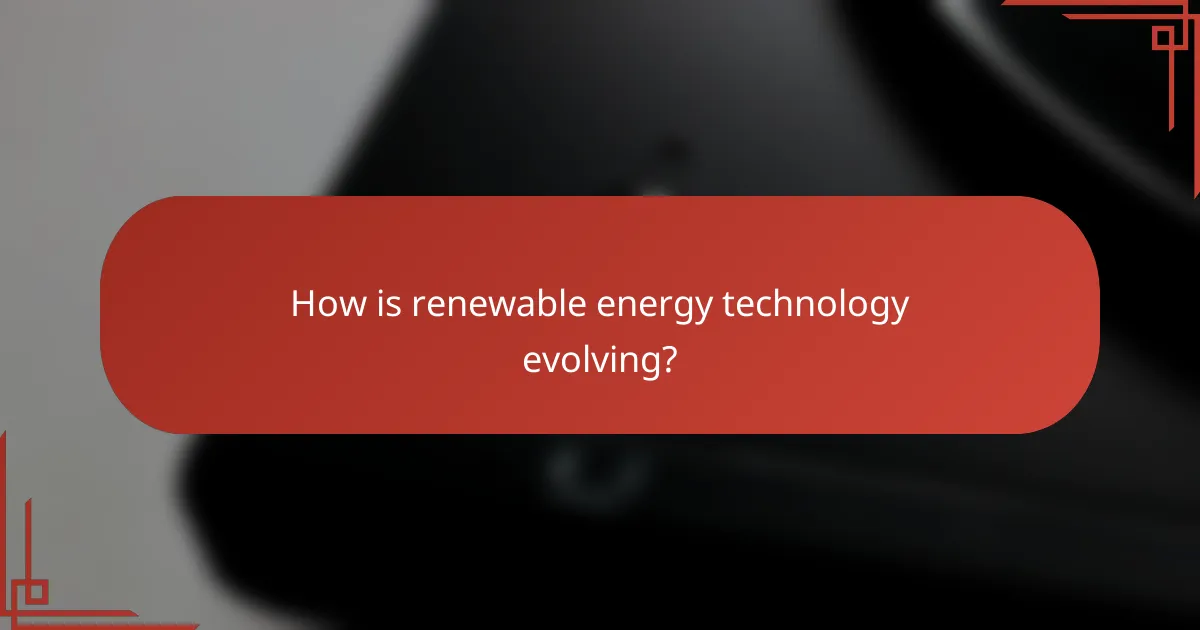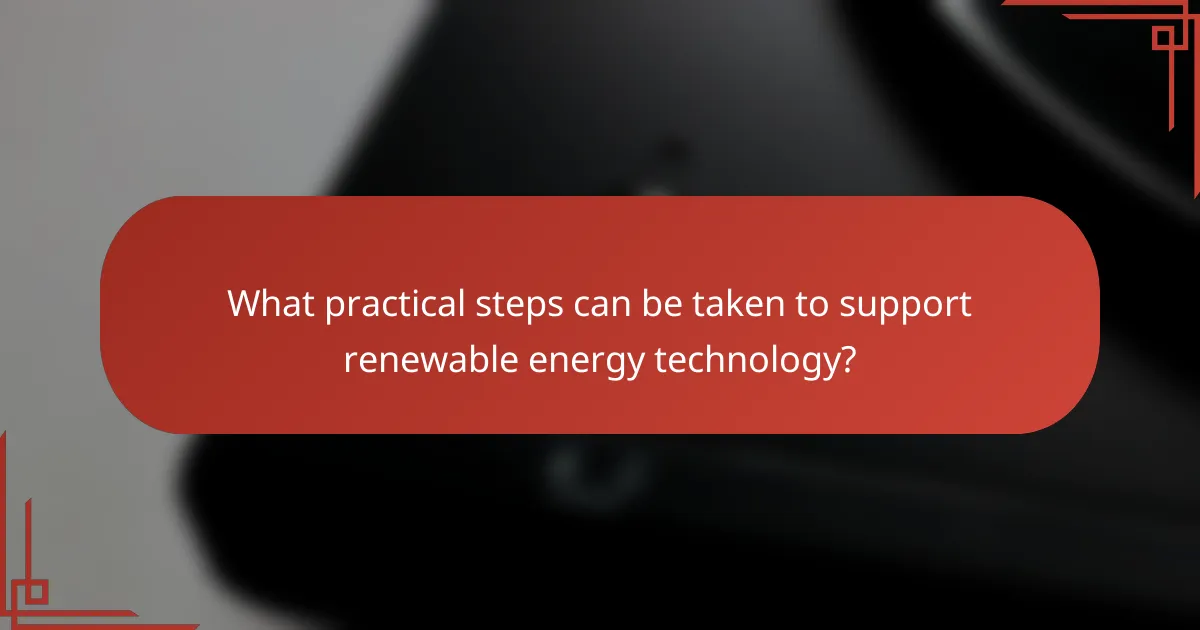Renewable energy technology is experiencing significant advancements across various sectors, including solar power, wind energy, and energy storage solutions. Solar photovoltaic cells have achieved efficiencies exceeding 22% in 2023, while global wind energy capacity has surpassed 900 GW. Improvements in lithium-ion batteries are enhancing energy storage capabilities, facilitating better integration of renewable sources. Additionally, smart grid technologies are optimizing energy distribution, and hydrogen fuel cells are emerging as a viable clean energy option. These trends reflect a substantial shift towards sustainable energy solutions, driven by increased investments and innovations aimed at reducing carbon emissions and supporting climate objectives.

What are the current trends in renewable energy technology?
Current trends in renewable energy technology include advancements in solar power, wind energy, and energy storage solutions. Solar power technology is increasingly efficient, with photovoltaic cells achieving over 22% efficiency in 2023. Wind energy installations are growing, with a global capacity exceeding 900 GW as of 2023. Energy storage technologies, especially lithium-ion batteries, are improving, allowing for better integration of renewable sources. Additionally, there is a rise in the use of smart grids to optimize energy distribution. Hydrogen fuel cells are gaining traction as a clean energy source for various applications. These trends indicate a significant shift towards sustainable energy solutions.
How are innovations shaping the future of renewable energy?
Innovations are significantly shaping the future of renewable energy by enhancing efficiency and reducing costs. For example, advancements in solar panel technology have led to a 90% decrease in costs since 2008. Wind energy technologies are now capable of generating power at lower wind speeds, expanding their viability. Energy storage solutions, such as lithium-ion batteries, have improved, enabling better integration of renewable sources into the grid. Smart grid technology allows for more efficient energy distribution and management. Additionally, artificial intelligence is optimizing energy consumption patterns in real time. These innovations collectively drive the transition towards a more sustainable energy landscape.
What are the most significant technological advancements in renewable energy?
The most significant technological advancements in renewable energy include improvements in solar photovoltaic efficiency, wind turbine design, and energy storage solutions. Solar panels now achieve efficiencies exceeding 22%, enhancing energy capture. Advanced wind turbines feature larger blades and higher capacity, increasing energy generation by up to 50%. Energy storage technologies, particularly lithium-ion batteries, have seen cost reductions of over 80% since 2010, enabling better management of intermittent renewable sources. Additionally, innovations in smart grid technology allow for more efficient energy distribution. These advancements collectively contribute to a more sustainable energy landscape.
How do these innovations improve energy efficiency?
Innovations in renewable energy technology improve energy efficiency by optimizing energy generation and reducing waste. Advanced solar panels convert sunlight into electricity with increased efficiency rates, often exceeding 20%. Wind turbines now harness wind energy more effectively, with modern designs capturing up to 50% of wind energy. Energy storage systems, like lithium-ion batteries, enable better management of energy supply and demand. Smart grids facilitate real-time monitoring and distribution of energy, minimizing losses. These advancements lead to reduced reliance on fossil fuels, contributing to lower carbon emissions. According to the International Renewable Energy Agency, renewable energy technologies have the potential to cut global energy consumption by 30% by 2030.
What role does market growth play in renewable energy adoption?
Market growth significantly accelerates renewable energy adoption. Increased market growth leads to lower costs for renewable technologies. For instance, the cost of solar photovoltaic systems has decreased by over 80% since 2010. This reduction makes renewable energy more accessible to consumers and businesses. Additionally, growing demand for clean energy drives investments in research and development. Enhanced competition among providers fosters innovation and efficiency. According to the International Renewable Energy Agency, global renewable energy capacity has expanded by 10% annually in recent years. This growth not only supports energy transition but also creates jobs in the sector. Thus, market growth is a crucial factor in promoting the widespread use of renewable energy.
What factors are driving market growth in renewable energy?
Increasing demand for clean energy is driving market growth in renewable energy. This demand arises from concerns about climate change and environmental sustainability. Government policies and regulations also support renewable energy adoption. Incentives such as tax credits and subsidies boost investment in this sector. Technological advancements reduce the cost of renewable energy production. For instance, the cost of solar photovoltaic systems has dropped by over 80% since 2010. Additionally, public awareness of energy security influences market growth. As fossil fuel prices fluctuate, renewable energy becomes more attractive. Finally, corporate commitments to sustainability are further accelerating the transition to renewable sources.
How does consumer demand impact renewable energy technologies?
Consumer demand significantly influences renewable energy technologies by driving innovation and market growth. Increased consumer interest in sustainability leads to higher investments in renewable energy solutions. This demand encourages companies to develop more efficient technologies. For example, the rise in solar panel installations is largely due to consumer preference for clean energy. According to the International Renewable Energy Agency, global solar capacity increased by 22% in 2020, driven by consumer demand. Additionally, consumers’ willingness to pay for green energy solutions prompts utilities to offer more renewable options. This shift in demand helps reduce costs through economies of scale. Ultimately, consumer demand shapes the renewable energy landscape by prioritizing sustainable practices and technological advancements.
What is the environmental impact of renewable energy technologies?
Renewable energy technologies have a significantly positive environmental impact. They reduce greenhouse gas emissions compared to fossil fuels. For example, wind and solar energy produce no direct emissions during operation. According to the International Renewable Energy Agency (IRENA), transitioning to renewable energy could reduce global CO2 emissions by up to 70% by 2050. Additionally, renewable technologies often require less water than traditional energy sources. This helps in conserving water resources, especially in arid regions. However, some renewable technologies can have localized environmental effects. For instance, large solar farms can disrupt local ecosystems. Despite this, the overall benefits of renewable energy technologies greatly outweigh these potential drawbacks.
How do renewable energy sources compare to fossil fuels in terms of environmental benefits?
Renewable energy sources provide significant environmental benefits compared to fossil fuels. They produce little to no greenhouse gas emissions during operation. This results in lower air pollution levels, which improves public health. Additionally, renewable energy reduces reliance on finite resources, promoting sustainability. According to the International Renewable Energy Agency, transitioning to renewables could reduce carbon emissions by up to 70% by 2050. Fossil fuels, in contrast, contribute to climate change and environmental degradation. They release harmful pollutants, leading to smog and respiratory illnesses. Overall, renewable energy sources offer cleaner, more sustainable alternatives to fossil fuels.
What are the long-term environmental impacts of renewable energy implementation?
Renewable energy implementation has several long-term environmental impacts. These include reduced greenhouse gas emissions, which mitigate climate change. For example, transitioning to wind and solar energy can cut carbon dioxide emissions by up to 80% compared to fossil fuels. Renewable energy also decreases air pollution, leading to improved public health outcomes. Studies show that cleaner air can reduce respiratory diseases significantly. Additionally, renewable energy sources require less water than traditional energy sources, conserving vital water resources. Furthermore, the development of renewable infrastructure can lead to habitat disruption, but careful planning can minimize these effects. Overall, renewable energy contributes positively to environmental sustainability in the long term.
How do trends in renewable energy technology influence policy and regulation?
Trends in renewable energy technology significantly influence policy and regulation. As technology advances, efficiency and cost-effectiveness improve. This leads to increased adoption of renewable sources like solar and wind. Policymakers respond by creating incentives for clean energy investments. Regulations often shift to support infrastructure development for these technologies. For instance, the U.S. saw the introduction of the Investment Tax Credit for solar energy. This credit has spurred growth in solar installations by providing financial benefits. Additionally, international agreements like the Paris Accord push countries to adopt cleaner energy solutions. These trends create a feedback loop, where technology advancements drive policy changes, and regulatory frameworks facilitate further innovation.
What are the challenges facing renewable energy technology today?
Renewable energy technology faces several significant challenges today. One major challenge is the intermittency of energy sources like solar and wind. This variability affects the reliability of energy supply. Energy storage solutions are still developing and can be costly. Another challenge is the need for substantial infrastructure investment. Upgrading the grid to accommodate renewable sources requires significant funding and planning. Additionally, regulatory hurdles can slow down the deployment of renewable technologies. Policies may not always support rapid innovation or adoption. Finally, public acceptance and awareness can hinder progress. Communities may resist new installations due to aesthetic or environmental concerns. These challenges collectively impact the growth and effectiveness of renewable energy technologies.
How do financial barriers affect the adoption of renewable energy technologies?
Financial barriers significantly hinder the adoption of renewable energy technologies. High upfront costs for installation and equipment deter many potential users. Limited access to financing options exacerbates this issue, particularly for low-income households. Additionally, the perception of financial risk associated with renewable investments discourages businesses. According to a 2020 report by the International Renewable Energy Agency, nearly 50% of respondents cited financial constraints as a primary barrier to adopting renewable energy. This highlights the critical impact of financial barriers on market growth in the renewable sector.
What technological challenges must be overcome for further advancements?
Technological challenges for advancements in renewable energy include energy storage, grid integration, and resource variability. Energy storage solutions, such as batteries, need to improve in efficiency and capacity. Current battery technology often limits the amount of energy that can be stored and used. Grid integration requires advancements in smart grid technology. This technology must efficiently manage distributed energy resources. Resource variability presents challenges in maintaining a consistent energy supply. Renewable sources like solar and wind depend on weather conditions, making reliability an issue. Addressing these challenges is crucial for scaling renewable energy technologies effectively.

How is renewable energy technology evolving?
Renewable energy technology is evolving through advancements in efficiency, storage, and integration. Solar panels now achieve over 22% efficiency, enhancing energy capture. Wind turbine designs are becoming larger and more efficient, with capacity factors exceeding 50%. Energy storage solutions, like lithium-ion batteries, are improving, allowing for better management of intermittent energy sources. Smart grid technologies enable real-time energy management and integration of diverse renewable sources. The global investment in renewable energy reached $303.5 billion in 2020, reflecting market growth. Furthermore, innovations in hydrogen production and usage are emerging, positioning hydrogen as a clean energy carrier. These developments collectively contribute to reducing carbon emissions and supporting climate goals.
What emerging technologies are on the horizon for renewable energy?
Emerging technologies on the horizon for renewable energy include advanced solar photovoltaic systems, offshore wind energy, and energy storage solutions. Advanced solar technologies, such as perovskite solar cells, promise higher efficiency and lower production costs. Offshore wind farms are increasingly being deployed, harnessing stronger and more consistent winds. Energy storage innovations, like solid-state batteries and pumped hydro storage, enhance grid reliability. Hydrogen production through electrolysis is gaining attention as a clean energy carrier. Furthermore, smart grid technologies optimize energy distribution and consumption. These developments are supported by significant investments and research initiatives, indicating a robust future for renewable energy innovation.
How is energy storage technology advancing in the renewable sector?
Energy storage technology is advancing rapidly in the renewable sector through innovations in battery efficiency and capacity. New lithium-ion batteries now offer energy densities exceeding 250 Wh/kg. Solid-state batteries are being developed, promising higher safety and energy density. Flow batteries are gaining traction for large-scale storage applications. These technologies enable better integration of intermittent renewable sources like solar and wind. According to the International Energy Agency, energy storage capacity grew by 40% in 2020 alone. This growth is crucial for grid stability and energy management. Enhanced storage solutions are vital for achieving global renewable energy targets.
What role does artificial intelligence play in renewable energy innovations?
Artificial intelligence significantly enhances renewable energy innovations. AI optimizes energy production by predicting demand and supply patterns. It analyzes vast datasets to improve the efficiency of renewable energy systems. For instance, AI algorithms can forecast solar and wind energy generation accurately. This leads to better integration of renewables into the energy grid. Additionally, AI facilitates predictive maintenance for renewable energy equipment. This reduces downtime and operational costs. According to a report by the International Renewable Energy Agency, AI applications can increase renewable energy productivity by up to 10%. Overall, AI plays a crucial role in advancing renewable energy technologies and improving their viability.
How are global markets adapting to renewable energy trends?
Global markets are adapting to renewable energy trends by increasing investments in clean technologies. In 2021, global investment in renewable energy reached $366 billion, reflecting a significant shift. Companies are diversifying their portfolios to include solar, wind, and energy storage solutions. Governments are implementing policies to incentivize renewable energy adoption. For instance, the European Union aims for a 55% reduction in greenhouse gas emissions by 2030. This regulatory push encourages innovation and market entry. Additionally, major corporations are committing to net-zero emissions targets, driving demand for renewable solutions. The rise of electric vehicles also contributes to this trend, boosting battery production and renewable energy integration. Overall, the adaptation is evident through increased financial commitment and regulatory support.
What regions are leading in renewable energy technology adoption?
Europe, particularly Germany and Denmark, is leading in renewable energy technology adoption. These countries have made significant investments in wind and solar power. Germany’s Energiewende policy aims for a substantial increase in renewable energy sources. Denmark generates about 47% of its electricity from wind power. Other regions include China, which is the largest producer of solar panels. The United States is also a significant player, especially in solar energy adoption. According to the International Renewable Energy Agency, global renewable energy capacity reached 2,799 GW in 2020. These statistics highlight the leadership of these regions in renewable energy technology.
How do international policies affect renewable energy markets?
International policies significantly influence renewable energy markets. These policies include agreements, regulations, and incentives that shape investment and development. For instance, the Paris Agreement encourages countries to reduce greenhouse gas emissions. This commitment drives nations to invest in renewable energy sources. Tax incentives and subsidies further stimulate market growth. According to the International Renewable Energy Agency, global renewable energy investments reached $300 billion in 2020, driven by supportive policies. Additionally, international trade agreements can facilitate the exchange of renewable technologies. Overall, international policies create a favorable environment for renewable energy expansion.

What practical steps can be taken to support renewable energy technology?
Investing in renewable energy infrastructure is essential to support technology. This includes building solar farms, wind turbines, and energy storage systems. Governments can provide incentives such as tax credits and grants. These financial supports encourage businesses and individuals to adopt renewable technologies. Additionally, increasing research funding accelerates innovation in renewable energy solutions. Education and training programs can develop a skilled workforce. Public awareness campaigns can promote the benefits of renewable energy. Collaborating with private sectors fosters partnerships that drive advancements. These steps collectively enhance the adoption and efficiency of renewable energy technologies.
How can individuals contribute to the growth of renewable energy?
Individuals can contribute to the growth of renewable energy by adopting sustainable practices and supporting clean energy initiatives. They can install solar panels on their homes, which can reduce reliance on fossil fuels. According to the Solar Energy Industries Association, residential solar installations increased by 20% in 2020. Individuals can also reduce energy consumption by using energy-efficient appliances and LED lighting. This can lead to lower energy bills and decreased demand for non-renewable energy sources.
Moreover, individuals can participate in community renewable energy projects, such as wind or solar cooperatives. These projects often provide local jobs and stimulate economic growth. Supporting policies and legislation that promote renewable energy is another effective way to contribute. Advocacy for clean energy policies can influence government decisions and funding.
Finally, educating others about the benefits of renewable energy can create a more informed public. Awareness can lead to increased demand for renewable energy solutions. By taking these actions, individuals play a crucial role in the transition to a sustainable energy future.
What are the best practices for adopting renewable energy solutions at home?
The best practices for adopting renewable energy solutions at home include conducting an energy audit, selecting appropriate technologies, and optimizing energy efficiency. An energy audit identifies consumption patterns and potential savings. Solar panels and wind turbines are common renewable technologies for residential use. Homeowners should evaluate local regulations and incentives for installation. Additionally, improving insulation and using energy-efficient appliances can enhance overall energy savings. Research shows that homes with solar power can reduce energy bills by up to 70%.
How can businesses integrate renewable energy technologies into their operations?
Businesses can integrate renewable energy technologies by adopting solar, wind, or geothermal systems. They can install solar panels on rooftops to generate electricity. Wind turbines can be set up on-site for additional energy production. Geothermal systems can provide heating and cooling solutions.
Companies may also invest in energy storage systems to manage energy supply. Utilizing energy management software can optimize energy usage and reduce costs. Collaborating with renewable energy providers can facilitate access to green energy sources.
According to the International Renewable Energy Agency, global renewable energy capacity reached 2,799 GW in 2020. This demonstrates the growing feasibility and benefits of integrating renewable technologies into business operations.
What resources are available for learning more about renewable energy innovations?
Online courses from platforms like Coursera and edX provide comprehensive learning on renewable energy innovations. These courses often feature contributions from leading universities and industry experts. Government websites, such as the U.S. Department of Energy, offer valuable reports and data on current innovations. Nonprofit organizations, like the Renewable Energy Policy Network, publish annual reports detailing advancements in the field. Academic journals, such as Renewable Energy and Energy Policy, present peer-reviewed research on the latest technologies. Industry conferences and webinars also serve as platforms for sharing cutting-edge developments in renewable energy. Books authored by experts in the field provide in-depth analysis and insights into emerging trends.
The main entity of this article is renewable energy technology, which encompasses advancements in solar power, wind energy, and energy storage solutions. The article outlines current trends, including increased efficiency in solar panels, growth in wind energy capacity, and innovations in energy storage, particularly lithium-ion batteries. It also discusses the significant role of market growth in driving renewable energy adoption, the environmental impacts of these technologies, and the challenges faced in the sector. Additionally, the article highlights emerging technologies and practical steps individuals and businesses can take to support the transition to renewable energy.


